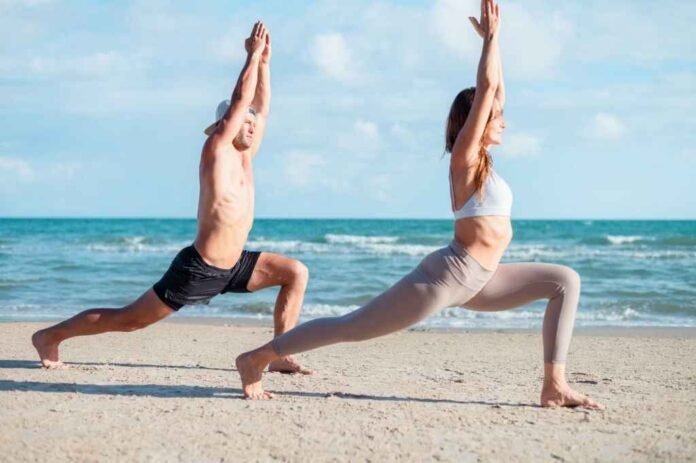Yoga is an exercise that goes beyond the individual. It’s no longer pretty much the relationship between thoughts and body; it’s also approximately the connection among human beings. Two-man or woman yoga poses, often referred to as associate yoga, bring a wholly new size to this historic exercise.
In this newsletter, we can dive deep into the arena of -man or woman yoga poses, exploring their blessings, supplying step-by-step instructions for some famous poses, and showcasing the splendor of practicing yoga with a partner. So, let’s embark on this adventure together and discover the concord of two-character yoga!
What Are Two Person Yoga Poses?
Two-man or woman yoga poses, additionally called partner yoga, contain training yoga with any other man or woman. It’s a beautiful manner to deepen your practice, construct trust, and create a sense of reference to your associate. These poses often require communique, cooperation, and a shared feeling of stability.
In partner yoga, the postures are modified to accommodate two individuals working together. Some poses involve supporting each other’s weight, while others rely on balance and counterbalance. The essence of two-person yoga lies in the shared experience of movement and breath.
Benefits of Two-Person Yoga
Partner yoga offers an extensive range of blessings that expand past the physical factors of the exercise. Here are some of the compelling motives why you need to don’t forget to try two-man or woman yoga:
- Enhanced Communication: Partner yoga encourages open communication between you and your partner. You must communicate clearly to coordinate movements and ensure safety.
- Builds Trust: Trust is the foundation of any successful partnership. Partner yoga exercises trust-building as you rely on your partner to support you in various poses.
- Deeper Stretching: Two-man or woman yoga allows you to reap deeper stretches with the help of your partner, supporting to improve flexibility.
- Strengthens Relationships: Sharing a yoga practice can strengthen the bond among companions, whether or not it’s a romantic accomplice, pal, or family member.
- Balances Energy: Partner yoga often involves balancing and counterbalancing, which can help balance your energy and improve stability.
- Emotional Connection: The shared experience of partner yoga can deepen your emotional connection with your partner, fostering a sense of togetherness.
- Fun and Playful: Partner yoga poses can be a lot of fun and inject an element of playfulness into your yoga practice.
Now that we’ve explored the benefits, let’s move on to preparing for a safe and enjoyable partner yoga session.
Safety First: Preparing for Partner Yoga
Before diving into two person yoga poses, it’s essential to prioritize safety. Here are a few key steps to follow:
- Choose the Right Partner: Ensure that you and your accomplice are like-minded in terms of physical abilities and consideration. Discuss any physical limitations or injuries beforehand.
- Warm-Up: Start with a gentle warm-up to prepare your body for the practice. Focus on stretching and loosening up your muscles.
- Clear Space: Find a spacious and clutter-free area to practice. Make sure there are no sharp objects or obstacles nearby.
- Use a Yoga Mat: Using a yoga mat provides cushioning and helps prevent slipping during poses that involve contact with the floor.
- Communicate: Maintain clear and open communication with your partner throughout the session. Discuss your intentions, comfort levels, and any concerns.
- Start Slow: Begin with simple poses and gradually progress to more complex ones as you and your partner become comfortable with the practice.
- Stay Mindful: Pay attention to your body’s signals. If a pose feels uncomfortable or painful, stop immediately and adjust as needed.
With these safety measures in mind, let’s explore ten amazing two person yoga poses that you can try with your partner.
10 Amazing Two Person Yoga Poses
Double Downward Dog
Instructions:
- Begin in a traditional Downward Dog position.
- Your partner should stand behind you, facing the same direction.
- Your partner places their hands on your hips, and you both press into the pose.
- Maintain alignment and balance, breathing deeply together.
Double Downward Dog is an excellent pose for stretching the spine and building trust with your partner.
Partner Boat Pose
Instructions:
- Sit facing your accomplice, with your knees bent and feet flat on the floor.
- Hold every other’s arms.
- Lean back slightly while lifting your legs, keeping them bent.
- Balance on your sitting bones and maintain this V shape.
Partner Boat Pose strengthens your core and challenges your balance while fostering a sense of togetherness.
Partner Camel Pose
Instructions:
- Stand facing your partner, about arm’s length apart.
- Reach your arms back and clasp your partner’s forearms.
- Slowly bend backward, opening your chest and heart center.
- Keep your core engaged and communicate with your partner for support.
Partner Camel Pose encourages vulnerability and trust while stretching the front of the body.
Seated Twist
Instructions:
- Sit go-legged when dealing with your partner.
- Place your proper hand on your companion’s left knee and your left hand on your proper knee.
- Inhale to prolong your spine, and exhale as you both twist to the right.
- Hold the twist for a few breaths, then switch sides.
Seated Twist promotes spinal flexibility and enhances the sense of connection between partners.
Back-to-Back Bend
Instructions:
- Stand back-to-back with your partner, feet hip-distance apart.
- Interlace your arms behind your back, and your partner does the same.
- Inhale and lift your chest as you both lean backward, creating a gentle backbend.
- Hold the pose, breathing deeply and synchronizing your movements.
Back-to-Back Bend encourages openness and shared balance while gently stretching the spine.
Child’s Pose Variation
Instructions:
- Both partners begin in Child’s Pose, kneeling with hips resting on heels.
- Extend your arms forward and place your palms on the mat.
- Your partner positions themselves behind you, lying on top of your back.
- Breathe deeply and relax into the stretch, feeling the gentle pressure of your partner’s weight.
Child’s Pose Variation deepens relaxation, fosters trust, and provides a comforting stretch.
Double Tree Pose
Instructions:
- Stand side by side with your partner, feet hip-distance apart.
- Reach for each other’s opposite hand.
- Lift your outside leg and place the sole of your foot against your inner thigh or calf.
- Find your balance and breathe together.
Double Tree Pose enhances balance, concentration, and the connection between partners.
Flying Warrior
Instructions:
- Stand facing your partner, about arm’s length apart.
- Partner A assumes a Warrior I pose, and Partner B supports by lifting Partner A’s extended leg.
- Partner B supports Partner A’s leg with their hands or forearms.
- Maintain balance and switch roles after a few breaths.
Flying Warrior builds trust and enhances balance and coordination between partners.
Wheelbarrow Pose
Instructions:
- Partner A begins in Downward Dog, while Partner B stands behind.
- Partner B places their hands on Partner A’s hips.
- Partner A shifts their weight forward onto their hands, and Partner B lifts their legs, creating a “wheelbarrow” shape.
- Maintain balance and communicate to find the right alignment.
Wheelbarrow Pose is a playful, core-strengthening pose that requires teamwork and trust.
Heart-to-Heart Meditation
Instructions:
- Sit going through your partner in a pass-legged role.
- Put your hands on one another’s hearts.
- Shut your eyes, take full breaths, and synchronize your breath alongside your accomplice’s.
- Focus on the connection and love between you both.
Heart-to-heart meditation cultivates emotional intimacy and a profound sense of connection.
Tips for a Successful Partner Yoga Session
Communication is Key: Always communicate openly with your partner. Discuss your intentions, comfort levels, and any adjustments you may need.
- Start Slow: Begin with easy poses and gradually progress to more challenging ones as your partnership develops.
- Focus on Breath: Syncing your breath with your partner’s can deepen your connection and help maintain balance.
- Use Props: Don’t hesitate to use props like yoga blocks or straps to assist in poses and make them more accessible.
- Be Patient: Partner yoga can be challenging, but it’s also rewarding. Be patient with yourself and your partner as you explore new poses.
Where to Practice Two-Person Yoga
You can practice partner yoga virtually anywhere, but it’s best enjoyed in a quiet, spacious environment. Consider practicing in your living room, a local park, or even on the beach. The choice of location should reflect your comfort and the type of partner yoga experience you desire.
Incorporating Partner Yoga into Your Routine
To fully experience the benefits of partner yoga, consider adding it to your weekly or monthly routine. Whether you practice with a romantic partner, friend, or family member, partner yoga can strengthen your bond and deepen your connection.
Incorporating partner yoga into your routine is as simple as setting aside dedicated time for practice. You can use online resources, like the LifeMaintain website, to discover new poses and routines that suit your preferences.
Conclusion
Two person yoga poses are a beautiful way to enhance your yoga practice, build trust, and deepen your connections with others. The benefits of partner yoga extend beyond the physical, fostering emotional intimacy and a sense of togetherness. As you explore the world of -person yoga, recall to prioritize protection, communique, and staying power.
Whether you are practicing with a romantic partner, buddy, or family member, associate yoga offers a completely unique possibility to share the adventure of self-discovery and connection. So, grasp an accomplice, roll out your yoga mats, and embark on an adventure of concord and connection through the practice of two-man or woman yoga.
Disclaimer: Before starting any new exercise routine, including partner yoga, consult with a healthcare professional, especially if you have any underlying medical conditions or injuries. Partner yoga should be practiced with caution, and any discomfort or pain during a pose should be addressed immediately.

